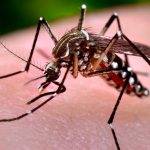
Aedes Aegypti, the mosquito that transmits yellow fever
YELLOW FEVER VACCINE
Welcome to the Yellow Fever Vaccine section of the Washington Travel Clinic website. This page contains valuable information on yellow fever and its prevention, as well as links to the CDC website where you can learn about country-specific recommendations and requirements for the yellow fever vaccine.
The Washington Travel Clinic is an approved site for the administration of the yellow fever vaccine. To qualify for the vaccine, the recipient must be nine months of age or older on the day of vaccination. Please review our charges in the pricing section and call us at (202) 521-8120 to make an appointment.
Travelers should get the yellow fever vaccine before visiting areas where yellow fever occurs. The clinician’s decision whether or not to vaccinate any traveler must take into account the traveler’s risk of being infected with the yellow fever virus, country entry requirements, and individual risk factors for serious adverse events after yellow fever vaccination (such as age and immune status). The yellow fever vaccine is given only at designated yellow fever vaccination centers, such as the Washington Travel Clinic. The yellow fever vaccine is administered in one dose under the skin and provides protection for life. However, certain countries require proof of vaccination within the last 10 years. Side effects are unusual, the most common being redness at the injection site.
For information on current outbreaks, consult CDC’s Travelers’ Health section. For country-specific recommendations and requirements, visit the CDC’s yellow fever section.
International regulations require proof of yellow fever immunization for travel to and from certain countries. People who get the yellow fever vaccine should be given an International Certificate of Vaccination. The certificate is provided during the same visit at no extra cost.
About Yellow Fever
Yellow fever is a life-threatening infectious disease caused by infection with the yellow fever virus, which is transmitted by the bite of infected mosquitoes. It occurs in tropical regions of Africa and in parts of South America.
Mosquitoes that spread yellow fever usually bite during the day, especially at dusk and dawn. Travelers should take precautions against mosquito bites when in areas with yellow fever transmission. The geographic range of the virus is South America and Africa.
There are two kinds of yellow fever, spread by two different cycles of infection:
Jungle yellow fever is mainly a disease of monkeys. It is spread from infected mosquitoes to monkeys in the tropical rain forest. People get jungle yellow fever when they are bitten by mosquitoes that have been infected after feeding on infected monkeys. Jungle yellow fever is rare and occurs mainly in persons who live or work in tropical rain forests.
Urban yellow fever is a disease of humans. It is spread by mosquitoes that have been infected by other people. Aedes aegypti is the type of mosquito that usually carries yellow fever from human to human. These mosquitoes have adapted to living among humans in cities, towns, and villages. Their larvae grow in discarded tires, flower pots, oil drums, and water storage containers close to human dwellings. Urban yellow fever is the cause of most yellow fever outbreaks and epidemics.
Illness ranges in severity from a self-limited febrile illness to severe hepatitis and hemorrhagic fever. Many yellow fever infections are mild, but the disease can cause severe, life-threatening illness. Symptoms of severe infection are high fever, chills, headache, muscle aches, vomiting, and backache. After a brief recovery period, the infection can lead to shock, bleeding, and kidney and liver failure. Liver failure causes jaundice (yellowing of the skin and the whites of the eyes), which gives yellow fever its name. Severe yellow fever infection can be fatal. Case-fatality rates from severe disease range from 15% to more than 50%.
There is no specific treatment for yellow fever. Treatment is symptomatic: rest, fluids, and ibuprofen, naproxen, or acetaminophen may relieve symptoms of fever and aching. Infected persons should be protected from further mosquito exposure (staying indoors and/or under a mosquito net during the first few days of illness) so that they can’t contribute to the transmission cycle.
Click here for more information about yellow fever from the CDC website.
About the Yellow Fever Vaccine
There is only one type of yellow fever vaccine available in the United States. It consists of an attenuated strain of the virus, which means that the virus is live but lost its ability to cause disease (except in very rare instances). The vaccine is injected under the skin and induces protection after 10 days.





